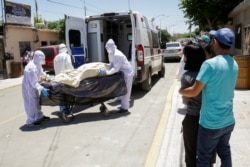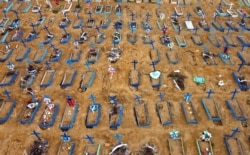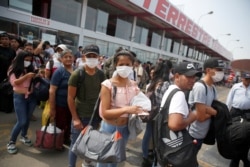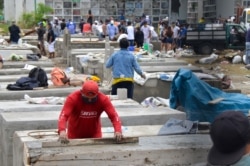On June 14, Mexico's president, Andrés Manuel López Obrador, said in a video posted on his official YouTube page: "We are leaving behind the most difficult stage of the COVID-19 pandemic. It is not to ring the bells, it is not to sing victory, but I consider that the worst is over."
His statement followed a spike in the number of new Mexican coronavirus cases in recent weeks, with a record 5,222 reported on June 12, and almost 3,500 more on June 13, according to official figures. The number of reported deaths neared 1,000 over those two days.
López Obrador’s assertion is misleading – but not unusual in Latin America, which on June 1 effectively became the new epicenter of the coronavirus pandemic. Multiple leaders have promoted optimistic projections concerning the virus or underreported the number of cases.
Polygraph.info looked at five Latin American countries where a lack of testing, ingrained inequality, corruption and troubled government systems mean the actual number of coronavirus cases is anyone's guess.
Mexico
Like many leaders, President López Obrador downplayed the severity of the coronavirus threat early on. On Feb. 28, when the country had its first confirmed case, the president said the virus was “not even as bad as the flu.”
In March, while the neighboring United States was shutting down, Mexico was functioning close to normal. Soccer tournaments and concerts were still allowed, and hugs were also in order (as suggested by the president himself).
Toward the end of that month, as cases climbed, a lockdown was declared. By the end of April, López Obrador declared the pandemic was under control. It wasn't.
Officials suggested mass testing for the virus wasn't essential. In May, Dr. Hugo Lopez-Gatell, a Mexican health ministry official, told CNN that mass testing was "quite inefficient as an assessment strategy," since it was "nonsensical to do test after test after test when most of those tests will result in a negative result."
A report released at the end of May by the group Mexicans Against Corruption and Impunity suggested that the death toll in the country was three times higher than the official numbers.
And a New York Times story that same month reported that a survey of hospitals around Mexico City found three times as many COVID-19 deaths as federal statistics showed.
At that time, Mexico was testing fewer than one in 1,000 people. Now, a month later, its testing capability remains considerably low. As of June 11, Mexico had conducted 2.82 tests per 1,000 people, fewer than Bangladesh (3.15 per 1,000 people), despite being six times wealthier, according to Our World in Data.
The country also has a shortage of doctors and nurses to properly respond to the pandemic. In April, it released a plan to hire 6,600 doctors and 12,300 nurses – and also concluded a $6 million dollar agreement with Cuba to bring nearly 600 Cuban doctors to the country, where they were supposed to stay until July. Last week, Mexico City's health secretary, Oliva López, told Reuters they could extend the Cuban doctors’ stay.
Reports from those working on the front lines describe a broken health care system and lack of equipment, which has meant an inability to properly care for the sick.
Still, the country moved to start reopening as early as June 1, when essential industries – like construction – were allowed to resume. Other sectors are set to follow in phases in the upcoming weeks.
Tourists started arriving in Cancun last week. Mexico’s tourism industry is desperate to reopen, leading the country’s tourism secretary to propose making the industry an "essential activity," as USA Today reported. Clubs from Liga MX, the top professional division of the Mexican soccer league system, returned to training this week as well.
Mexico's coronavirus crisis continues to deepen. As of June 17, John Hopkins University’s widely cited data map showed nearly 160,000 confirmed COVID-19 cases and over 19,000 deaths, with an increase of close to 5,000 cases and 800 deaths in just the past 24 hours.
(Johns Hopkins’ media team said its counts include both data that is officially reported around the globe and from additional sources when official reports are “deemed to be incomplete.” They also cautioned that most countries are likely to be underreporting cases “due to the monumental challenge of keeping pace” with the virus.)
Brazil
Brazil is, by far, the coronavirus epicenter in Latin America. The country now has the second-highest number of cases in the world, behind the U.S. As of June 17, there were nearly 956,000 confirmed COVID-19 cases and over 46,500 deaths, according to John Hopkins.
Due to a lack of widespread testing, the real numbers are likely much higher. A national study in May estimated cases were seven times higher than what's officially reported.
Brazil’s president, Jair Bolsonaro, has played down the dangers of the virus, calling it a "little flu," pressing for the end of isolation policies in states and promoting use of hydroxychloroquine, an anti-malaria drug that has not been proven effective against COVID-19. He has also encouraged and taken part in anti-isolation protests.
Bolsonaro fired his first health minister, Henrique Mandetta, in April, and Mandetta’s successor, Nelson Teich, resigned in May, after only a month in the job.
With Bolsonaro’s third health minister, Eduardo Pazuello, a military general, in place, the government changed the time when it releases the daily COVID-19 statistics to 10 p.m. Experts criticized the move, saying it made it harder to inform the population. News agencies also expressed disapproval, noting that the updated numbers wouldn’t be available during prime time.
Bolsonaro said the change was meant to "avoid underreporting and inconsistencies."
The government has also stopped publishing the overall number of coronavirus cases and deaths, instead releasing only daily numbers.
According to Health Minister Pazuello, the change was made to provide "100% transparency and data for everyone.” But health specialists, politicians and citizens condemned the move, arguing that releasing data only on the dates on which deaths occur won't allow for a transparent monitoring of the disease’s progression. And since it takes a few days for deaths to be counted, they said, it could create a false sense that deaths are decreasing and lead people to be less cautious. The ministry was forced to back down.
In Rio de Janeiro’s favelas, low-income shanty towns, deaths outnumber those in most of greater Rio's municipalities. Drug lords have taken matters into their own hands, imposing curfews, social distancing and food handouts. Experts say environments like the favelas – crowded and with poor sanitation – are places where the virus can spread rapidly.
Over a quarter of Brazil's population lives in poverty, many in rural areas with little to no health care infrastructure. As of June, one third of the country’s COVID-19 cases were already in these areas. Inhabitants must rely on already overwhelmed hospitals in state capitals, where 48% of all ICU beds in Brazil are concentrated, according to the National Registry of Health Establishments (CNES).
Chile
Chile confirmed its first COVID-19 case on March 3, and on March 19, the government declared a nationwide state of catastrophe for 90 days. It included banning public gatherings, limiting travel and controlling distribution of necessities.
Chilean health minister, Jaime Mañalich, however, promoted a policy of dynamic lockdown – restricting movement in specific neighborhoods instead of entire cities. In an April 12 interview, President Sebastián Piñera said a nationwide lockdown wasn't sustainable, since "no one could ensure that quarantined families have the medicines, food and basic services.”
The government abandoned that policy in May as new cases spiraled in poorer and more crowded communities.
Despite being one of the first Latin American countries to implement emergency measures, the number of victims in the country has risen steadily. Over 3,380 deaths have been officially reported – meaning 19.3 deaths per 100,000 people, just behind Brazil (22.2), Peru (22.7) and Ecuador (23.45), according to John Hopkins data.
Mañalich resigned on June 13 amid controversy over figures released to the World Health Organization on the number of coronavirus deaths in Chile. According to the Chilean newspaper Ciper, the figure of 5,000 deaths reported to the WHO was much higher than what was officially released in Chile.
On June 16, Chile’s Health Ministry announced it would be adjusting the number of coronavirus cases, to include 31,412 previously unaccounted for, due to delays in the process of notifying and updating the system. As of June 17, John Hopkins reported more than 220,600 cases and over 3,600 deaths in the country.
The government also had plans to give out "immunity passports," so that those who had tested positive for antibodies could return to work. However, it quickly backtracked given that immunity for those who’ve been infected by coronavirus remains uncertain.
Peru
The country is grappling with the second-worst COVID-19 outbreak in the region: nearly 241,000 cases and 7,260 deaths, according to John Hopkins. But even César Munayco, a specialist at Peru’s Ministry of Health (Minsa), said the true numbers are likely higher – and could be twice as high, considering deaths suspected to be caused by coronavirus but not yet confirmed.
In an interview with Peruvian Network RPP on June 7, he explained that, "In total, the deceased suspects by COVID-19 are 14,000. 8,500 have tested positive for rapid tests, and they are still confirming the remaining 6,000 cases.”
Despite early action to contain the outbreak, strict lockdown policies and generous economic aid packages, Peru couldn't avoid the calamities of the outbreak.
Many Peruvians couldn't comply with quarantine measures, experts say. For example, to access aid programs, many people lined up outside banks to receive checks. According to the World Bank, almost 60% of Peruvians do not have bank accounts. Those not able to receive aid fled back to their villages – many walking for several days and hundreds of miles.
As the New York Times reported, at least 167,000 people who had moved to urban areas for work scrambled to return to the countryside, some likely taking the virus with them.
People had to leave their homes repeatedly to get food. According to a 2018 government survey, 44% of Peru's households do not have refrigerators and must buy basic necessities in food markets, where social distancing is almost impossible.
The markets became hubs of infection. In April, 842 food sellers in one busy market in Lima were tested for coronavirus, and 163 came back positive. The market was closed, but it was only one out of thousands in the city.
Despite government efforts to boost the health care capacity (including doubling the number of hospital beds to 20,000 and ICU beds to 2,000), decades of underinvestment meant overwhelmed and unprepared hospitals and soaring drug prices from shortages.
On May 17, one of the country's top infectious disease experts, Ciro Maquiña, warned of an approaching collapse of Peru's healthcare system. In June, 85 Cuban doctors joined the pandemic fight there.
Ecuador
Coronavirus came to debt-ridden Ecuador as the country faced an economic crisis, collapse in exports and the rupture of major oil pipelines.
Ecuador has the highest number of COVID-19 deaths per capita in the region: 23.45 per 100,000 people, according to John Hopkins.
Members of some families have had to search through body bags in morgues to find deceased relatives. Others don't know what became of relatives are after they were admitted into hospitals. In Guayaquil, some people had to wait for days for emergency services to collect the bodies of their dead relatives – and would resort to leaving the bodies on the streets.
And many COVID-19 cases and deaths are not reported. On April 2, Ecuador’s President Lenín Moreno admitted in a public address that his government knew "that both the number of infections and the number of deaths [were] falling short."
A New York Times’ analysis that compared actual versus typical mortality rates suggested that between March and May, Ecuador recorded around 10,500 more deaths than in the previous three years – or six times higher than the official tally. And in April, an update of Ministry of Health figures nearly doubled the number of coronavirus cases.
After various discrepancies appeared in official counts, Ecuadorian officials changed their methodology for counting the number of cases to one based on people having symptoms, regardless of tests.
The country is also investigating possible corruption cases related to purchase of medical equipment during the pandemic – involving, among others, former president Abdala Bucaram.
Asked about mistakes made in response to the pandemic, President Moreno told NTN24 Network that “perhaps not being diligent enough to know how to determine the human element, the administrative, technological, and input elements that should be available at a given time. No one knew exactly how the coronavirus issue worked.”
On June 12, a major lab in Quito, Ecuador's capital, halted the processing of coronavirus tests because workers didn't have basic supplies, such as masks, gloves, tubes and pipettes, to safely analyze specimens. According to the country’s health ministry, Ecuador had carried out close to 133,460 tests up to that point.
As of June 17, Ecuador had nearly 48,500 cases and over 4,000 deaths, according to John Hopkins.










